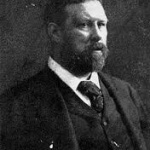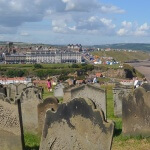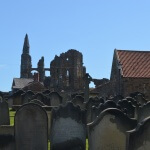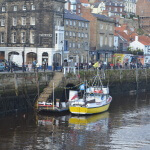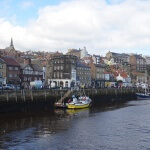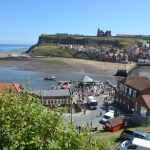Abraham “Bram” Stoker
8 November 1847 – 20 April 1912)
Bram Stoker was an Irish author, best known today for his 1897 Gothic novel, Dracula. During his lifetime, he was better known as personal assistant of actor Henry Irving and business manager of the Lyceum Theatre in London, which Irving owned.
Stoker was born on 8 November 1847 at 15 Marino Crescent, Clontarf, on the northside of Dublin, Ireland. His parents were Abraham Stoker (1799–1876), from Dublin, and Charlotte Mathilda Blake Thornley (1818–1901), who was raised in County Sligo. Stoker was the third of seven children, the eldest of whom was Sir Thornley Stoker, 1st Bt. Abraham and Charlotte were members of the Church of Ireland Parish of Clontarf and attended the parish church with their children, who were baptised there.
Stoker was bedridden with an unknown illness until he started school at the age of seven, when he made a complete recovery. Of this time, Stoker wrote, “I was naturally thoughtful, and the leisure of long illness gave opportunity for many thoughts which were fruitful according to their kind in later years.” He was educated in a private school run by the Rev. William Woods.
After his recovery, he grew up without further major health issues, even excelling as an athlete (he was named University Athlete) at Trinity College, Dublin, which he attended from 1864 to 1870. He graduated with honours as a B.A. in Mathematics. He was auditor of the College Historical Society (“the Hist”) and president of the University Philosophical Society, where his first paper was on “Sensationalism in Fiction and Society”.
Stoker visited the English town of Whitby in 1890 and that visit is said to be part of the inspiration of his great novel Dracula. While manager for Henry Irving and secretary and director of London’s Lyceum Theatre, he began writing novels, beginning with The Snake’s Pass in 1890 and Dracula in 1897. During this period, Stoker was part of the literary staff of the The Daily Telegraph in London, and wrote other fiction, including the horror novels The Lady of the Shroud (1909) and The Lair of the White Worm (1911). In 1906, after Irving’s death, he published his Personal Reminiscences of Henry Irving, which proved successful, and managed productions at the Prince of Wales Theatre.
Before writing Dracula Stoker met Ármin Vámbéry, a Hungarian writer and traveler. Dracula likely emerged from Vámbéry’s dark stories of the Carpathian mountains.[9] Stoker then spent several years researching European folklore and mythological stories of vampires.
Dracula is an epistolary novel, written as a collection of realistic, but completely fictional, diary entries, telegrams, letters, ship’s logs, and newspaper clippings, all of which added a level of detailed realism to the story, a skill Stoker had developed as a newspaper writer. At the time of its publication, Dracula was considered a “straightforward horror novel” based on imaginary creations of supernatural life. “It gave form to a universal fantasy . . . and became a part of popular culture.”
According to the Encyclopedia of World Biography, Stoker’s stories are today included in the categories of “horror fiction”, “romanticized Gothic” stories, and “melodrama.” They are classified alongside other “works of popular fiction” such as Mary Shelley’s Frankenstein which according to historian Jules Zanger, also used the “myth-making” and story-telling method of having “multiple narrators” telling the same tale from different perspectives. “‘They can’t all be lying,’ thinks the reader.”
The original 541-page manuscript of Dracula was believed to have been lost until it was found in a barn in northwestern Pennsylvania in the early 1980s. It included the typed manuscript with many corrections, and handwritten on the title page was “THE UN-DEAD.” The author’s name was shown at the bottom as Bram Stoker. Author Robert Latham remarked: “the most famous horror novel ever published, its title changed at the last minute.” The manuscript was purchased by Microsoft co-founder Paul Allen.
Stoker’s inspirations for the story, in addition to Whitby, may have included a visit to Slains Castle in Aberdeenshire, a visit to the crypts of St. Michan’s Church in Dublin and the novella Carmilla by Sheridan Le Fanu.


